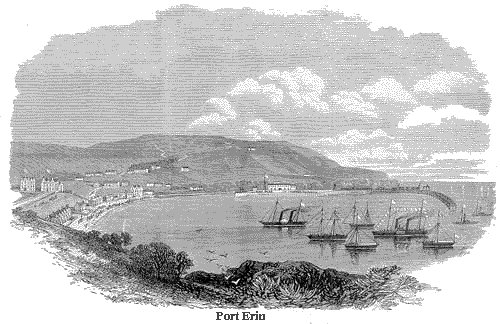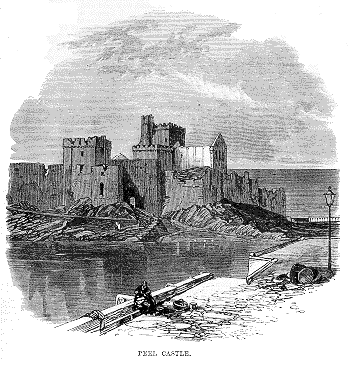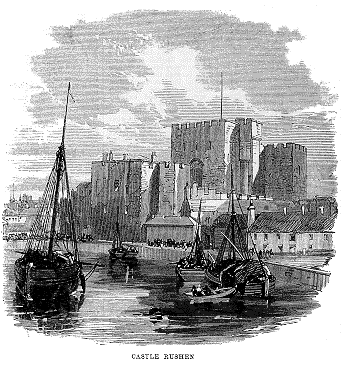
[ILN 22 May 1869]

The beautiful bay of Port Erin. where Prince Arthur landed in his late visit to the Isle of Man, is situated on the west side of that island, about three miles north of the Calf of Man. It is naturally protected from winds blowing from the north, south, and east, but is exposed to the violent storms from the westward which rage in the Irish Channel during the winter mouths. A breakwater is now in course of construction at the entrance to the bay, which, when completed, will make Port Erin harbour the safest and most sheltered on the coast of the Isle of Man. This breakwater was designed by Mr. John Coode, C.E., of London, the engineer-inchief. It is constructed of a rubble mound, the materials of which are tipped from a staging by a method similar to that which is adopted at Portland breakwater. The mound is protected from the "on of the sea by massive blocks of concrete, each weighing 17 tons, which am not built as a wall of masonry, but dropped into the sea, like those used in Port Said, at the Mediterranean entrance to the Suez Canal. Prince Arthur arrived here from Belfast, in the Royal steam-yacht Vivid, on Tuesday, the 4th inst., about mid-clay, and anchored in the bay. His Excellency Mr. H. B. Loch, C.B., the Lieutenant- Governor of the Isle of Man, accompanied by Mr. M. H. Quayle, Clerk of the Rolls, immediately went on board to receive the Prince. They conducted him and his suite, including Colonel Elphinstone and Lieutenant Pickard, to the breakwater, where a suitable landing-stage had been specially erected. Here the Prince was received by Mr. William Powell, the resident engineer, with his assistant, Mr. Whately Eliot, His Royal Highness proceeded through the works to the carriages which were waiting at the entrance-gate, and at once drove to Castletown, and thence to Douglas.
Arriving at Castletown about two o'clock, the Prince visited Castle Rushen under the guidance of the Governor, the Clerk of the Rolls, and Mr. J. T. Clucas, Secretary and Treasurer to the Island Goverment. This ancient fortress which was founded by the danish Kings of Man, in the tenth century, though its oldest remaining portion, the central keep, is of the thirteenth century, now contains the gaol, the courthouse, and the lunatic asylum of the island; the Governor's residence and the House of Keys, or local Parliament, have been removed to other buildings. The castle is built of dark-blue limestone, with massive architecture, its walls being 11 ft. or 12 ft. thick. It was formerly surrounded by a deep moat, with seven square towers and three round towers upon the external glacis. The central keep has four towers 70 ft. high, one of which contains the old chapel of the castle. It was to this ware abode, in 1644, that the famous Countess Charlotte of Derby (well known to the readers of Scott's "Peveril of the Peak ") retired with her husband after the siege of Lathom House, which she had so bravely defended against the army of the Commonwealth. The Earl of Derby, however, did not stay quietly and safely in his "Kingdom of Man," but, seven years later, joining the army of Charles II. was defeated, and lost his life on the scaffold at Bolton, Lancashire.
Prince Arthur remained at Douglas on the Tuesday evening; he received several loyal addresses, dined at Government House, and slept at the Castle Mona Hotel. Returning through Peel next day to Port Erin, he embarked, in the afternoon, on board the Vivid. which had remained anchored in the bay, and started immediately for Liverpool. The town and port of Peel, situated on the west coast of the island, are sheltered by a little rocky islet, called St. Patrick's, which is artificially joined to the shore by a line of stepping-stones, or causeway. On this islet are a primitive round tower; the ruins of the ancient cathedral of St. Germain, in the Early Decorated style of architecture, built in the thirteenth century; those of the old Church of St. Patrick; and those of Peel Castle, all within an extent of five acres, surrounded by an embattled wall flanked with towers, The High. Bailiff of Peel Mr. R. J. Moore, showed the place to his Royal Highness, who viewed it with much interest.
We present some Illustrations of Port Erin, Peel Castle, and Castle Rushen, the two latter being from photographs by Mr. G. A. Dean, of Athol-street, Douglas.


Another take on the visit was provided by the satirical Liverpool journal The Porcupine whose editor/owner was Hugh Shimmin.
THE PORCUPINE. Liverpool, May 8, 1869.
PRINCE ARTHUR IN MONA'S ISLE. HEARING when in Ireland that Mr. PORCUPINE was about to spend a short time in his "own dear Ellen Vannin, with its green hills by the sea," and being very anxious to have a friendly chat with him upon national and domestic topics, his Royal Highness "wired" big wish to the sage, saying, "I will call round, and spend a day with you in your island home." Great was the delight of the High Bailiff of Douglas. Radiantly beamed his face, joyously robbed he his hands, when Mr. PORCUPINE showed him the Prince's message. Of course the Governor of the island was not at home, and of course the High Bailiff thought he might be sent for; but upon such a delicate point Mr. PORCUPINE declined to offer an opinion. However, as things for ornament so well as those for use would doubtless be required during the Prince's stay, the High Bailiff felt that it would perhaps be as well for the Governor of the island "to be in his place once in a way," and therefore telegraphed to him and also to Deemster Drinkwater, who both with becoming consideration obeyed the summons, and returned to the island last Saturday. The presence of Mr. PORCUPINE on Douglas Pier to receive them called forth marked enthusiasm, and amidst the ringing cheers of the multitude for "PORCUPINE, the Prince's friend," the Governor and Deemster passed on to their carriages, totally unheeded except by a few policemen.
The islanders had not, in the meantime, been idle. PORCUPINE's message had touched a chord of their hearts which vibrated quickly and harmoniousaly, and his presence inspired prompt and vigorous action. Moreover, the High Bailiff of Douglas has not lived so long, travelled so far, or learned so much in vain. His loyalty and patriotism need but a spark to kindle them into a flame, and what he feels himself he can readily impart to others. Therefore it was that a public meeting, a subscription list, declaration of a general holiday, resolutions relative to reception of the Prince and presentation of addresses, all fell in line rapidly, and with the precision of a well-drilled corps on parade. Bonfires were to blaze, fireworks were to fizz, triumphal arches were to arise, bands of music were to be brought over, flags were to float in the breeze, house. holders and shopkeepers were to vie with each other in lighting up the darkness of Douglas; and, as people at street corners, in the Market place, or near the Promenade, read the placards announcing all these delights, they turned to each other with uplifted bands and wondering eyes, exclaiming, "Great indeed is Douglas, and Harris is its High Bailiff!"*
It was expected that the Prince would land in Douglas, but the weather proved unfavourable. A strong easterly wind set in, and on Tuesday morning Mr. PORCUPINE received a message that the Prince would be glad to see him at Port Erin about twelve o'clock. Mr. PORCUPINE lost no time; and, soon after nine o'clock, bidding the High Bailiff "good morning" at the Courthouse, Athol-street, he set off for Port Erin, escorted by the " Press Guard" of the island, to which were added some of the Liverpool corps, and followed by the Governor and the Clerk of the Rolls. These functionaries had to take Castletown on their way; but Mr. PORCUPINE and his escort pushed on through Kirk Arbory and "the Level" to Port Erin, not failing to notice, as they passed, the fine-swelling hills, the bright emerald fields, fantastically and richly fringed with the golden gorse exuberant in its loveliness, and the neatly-kept gardens and cottages which distinguish the drive from Ballasalla to Port Erin.
Mr. PORCUPINE was not altogether sorry that the Prince landed at what was once a beautiful little port, because it gave Mr. P. an opportunity of explaining to his Royal Highness and attendants the persistent and costly attempts which have been made by what the islanders call "the Breakwater fellows" to disfigure, and in all probability destroy, the prettiest and most romantic bay and bit of coast scenery in the Isle of Man. The Governor, who stood aside while the Prince cordially greeted his old friend, Mr. PORCUPINE, was mach surprised at the warmth and fervour which his Royal Highness displayed; but neither Governor Loch nor his Keys know anything of the peculiar ties which exist between the family of her most gracious Majesty and Mr. PORCUPINE, and perhaps never will! Had he been quick. witted-had he been a patent detector Loch-he might have well nigh guessed the secret bond of good and odd-fellowship when he heard the Prince ask, " Well, Mr. PORCUPINE, how is Jeffery, and how are our good friends, the Financial Reformers, going on?" Major Elphinstone saw what was meant in a moment. A shrewd man is the Major, and a nice berth he has with it! As the Prince walked from the ruins of the Breakwater to the carriages in waiting Mr. PORCUPINE took occasion to point out to his young friend that already abont £50,000 had been spent in trying to spoil the harbour of Port Erin, and that by the time double that sum was spent success might crown the effort, and the harbour be rendered neither picturesque, ornamental, nor useful-all of which it had been for generations past. The Governor smiled in a very sickly fashion at Mr. PORCUPINE's remark; but, as the Prince graciously and with feeling observed, the smile seemed to be on the wrong side of the face!
The drive from Port Erin to Castletown was greatly enjoyed by the Prince. Poolvash Bay and Port St. Mary, with the bold headland to the right, called forth warm encomioms on the coast scenery of the island. The stay at Castle Rushen was very short, but the opportunity was seized upon for showing the Prince the old well in the castle, at the bottom of which Manx truth is supposed to be found, but which is rarely fathomed by the functionaries. The day was beautifully fine, the air clear and bracing, and during the ride from Castletown to Douglas the Prince was greatly impressed with the richness, variety, beauty, and grandeur of the scenery. But the Prince's enjoyment of the drive was. greatly marred by the persistent manner in which a few Manx galloping snobs on horseback pressed upon the aides of the carriage. They had come from Douglas (unasked, of course), - and, if Mr. PORCUPINE could- have had his way, they should not have been allowed to return in a manner so agreeable to themselves or so inconsistent with gentlemanly feeling or good taste.
At Douglas a truly magnificent reception awaited the Prince. From the entrance to the Nunnery Grounds down to Castle Mona the streets and houses were thronged with loyal and enthusiastic multitudes, and the cheering at some points was almost up to the English mark. The scene at Castle Mona, when the Volunteers (a splendid body of artillery) formed the guard, and the students from King William's College formed a crescent as the Prince drew up, was in every way enjoyable and effective. The presentation of the addresses from the insular Legislature, and other official bodies, was at once proceeded with, and the Prince got through all with ease, elegance, and becoming dignity. The only time we noticed that he gave way in the slightest degree was when the deputation from King William's College was introduced. Dr. Jones, in his bright red robes, was enough to stagger an older and stronger Prince than Arthur. As the High Bailiff observed to the Deemster, "however well read in learning and literature the reverend doctor might be, he was, in that costume, too much red for anything." But envy has various modes of displaying itself, and there were people present during the ceremony who would have liked to have distinguished themselves as much as Dr. Jones did. The depotsitions, on the whole, did their work fairly. The representative of Peel was slightly nervous-the representative of Ramsey was emphatic and feeling-the representative of Castletown was almost himself; but the High Bailiff of Douglas was, as the Americans say, " all thar." He was so anxious to rattle on with his reading that he forgot where he was, or who ought to be before him; and the Governor had slightly to slew Mr. Harris around, in order that he might address the Prince, and not the windows facing the bay. After dining with Mr. PORCUPINE-the majority of the people suppose he dined with the Governor-the prince drove through the town to see the illuminations, and reached the ballroom of Castle Mona before midnight. Next day he visited Peel town and castle, and drove from there to Port Erin, where he parted very affectionately with his trusty guide, philosopher, and friend, calling out, as he was being rowed on board the Vivid, "As I am going to Liverpool, I will be sure to call on Jeffery."
Mr. PORCUPINE cannot close this hasty sketch without thanking the Mayor and Corporation of Liverpool for the loan of the royal standard which floated gaily from his flag-tower in Mona's Isle during the Princes stay.
*In order that this remark may be fully understood, it will be necessary to enumerate the offices which Mr. Harris holds. He is the Registrar of Deeds, Episcopal Registrar, Secretary to the Bishop, Surrogate, Registrar of Joint stock Companies, Registrar-General of Births and Marriages, Coroner for Inquests, Inspector of Weights and Measures, President of the District Court for Granting Public-house Licenses, Justice of the Peace, and High Bailiff of Douglas
|
|
||
|
Any comments, errors or omissions
gratefully received The
Editor |
||